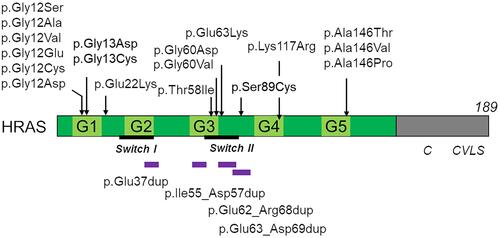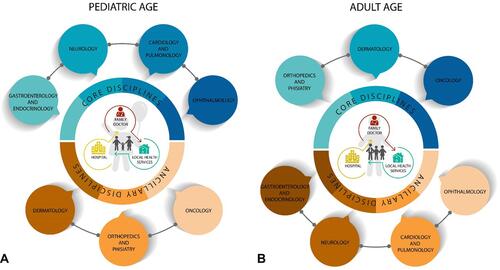Figures & data
Figure 1 HRAS domain structure and pathogenic variants of HRAS identified in patients with Costello syndrome. Upper panel shows missense mutations, and lower panel shows intragenic duplications. More than 90% of pathogenic variants are clustered in codons 12 and 13. It has been shown that mutations at these codons impair the intrinsic GTPase activity, resulting in constitutive activations of downstream effectors.Citation3,Citation9,Citation136 Reproduced from Aoki Y, Niihori T, Banjo T, et al. Gain-of-function mutations in RIT1 cause Noonan syndrome, a RAS/MAPK pathway syndrome. Am J Hum Genet. 2013;93(1):173–180. Copyright © 2013 The American Society of Human Genetics. Published by Elsevier Inc. All rights reserved.Citation137 The de novo 10-nucleotide-long deletion within the intron-D-exon (IDX) is not shown in the figure.

Table 1 Genotype-phenotype relationships in Costello syndrome with missense HRAS variants, duplications, and deletions
Figure 2 Core and ancillary disciplines involved in the management of pediatric and adult patients with CS. The impact of medical issues in the daily lives of patients with CS requires careful management throughout life. A comprehensive multidisciplinary assessment to be performed by physicians and therapists is needed from infancy to adulthood to promptly treat and monitor comorbidities. The latter change according to patients’ age. In particular, the most concerning problem to manage in children is related to failure to thrive. The cardiorespiratory system needs to be accurately evaluated to exclude severe morphological or rhythmic cardiac anomalies. Visual and global neurological functions need to be assessed in order to plan a personalized protocol of habilitative therapies (A). In adults, orthopedic manifestations often require treatment; a comprehensive dermatological evaluation is important to improve skin findings, and a surveillance protocol for cancer risk needs to be followed (B).

Table 2 Timing of Clinical and Instrumental Follow-Up According to Literature and Our Experience
